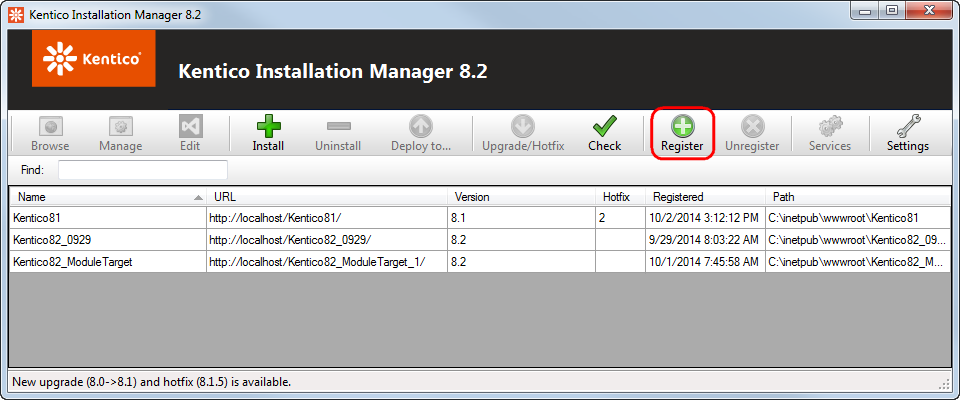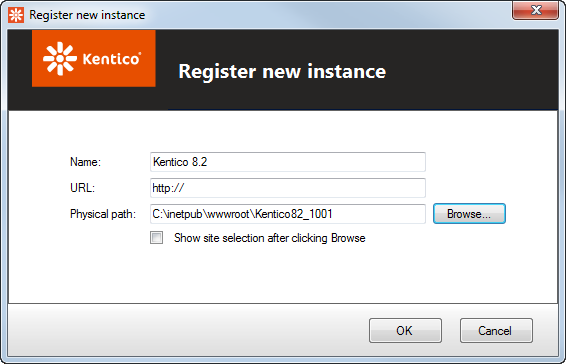Registering an instance in KIM
When you install a new Kentico instance on a machine, it is automatically registered within Kentico Installation Manager. In some cases though, you may need to register instances manually. For example:
- Instances transferred or copied onto the machine without going through the installation
- Microsoft Azure projects
Registering an instance in KIM
Requirements:
- KIM is compatible with Kentico instances starting from the previous major version. For example, you can register instances of Kentico 7 or 8 (any minor version) in KIM 8.2.
- For instances of Kentico 8 or newer, you can only register complete web projects that use the standard folder structure (including the solution file, CMS and Lib sub-folders etc.). For example, you cannot add web site deployments of the CMS folder as instances in KIM.
Click Register on the main toolbar.

Enter the following details:
- Name - identifying name of the instance displayed in the Name column in the list of instances.
- URL - the URL under which the instance is accessible.
- Physical path - path to the instance’s web project root folder in the file system.
- Show site selection after clicking Browse - if enabled, the tool displays a dialog with available web sites of the particular instance after clicking the Browse button (useful for multi-site instances).

Click OK.
The KIM registers your instance and displays it in the list of managed instances.
Where is the information stored
Information about registered instances is stored in c:\ProgramData\KIM\kim.xml. The root <sites> element contains <item> elements that represent individual registered instances. The <item> elements have the following sub-elements representing properties of the registered instances:
<guid> - unique identifier of the instance (not related to the application GUID in the web.config file of the given instance).
<url> - URL under which the instance is accessible.
<name> - identifying name of the instance displayed in the Name column in the list of instances.
<version> - version of Kentico.
<path> - path to the instance’s web project root folder in the file system.
<created> - date and time when the instance was registered in Kentico Installation Manager.
<hotfix> - number of the latest hotfix applied to the instance.
<netversion> - represents the .NET Framework version used by the instance. The stored number does not match the .NET version, using the following encoding instead:
.NET version
Encoding number
2
2
3.5
4
4
8
4.5
16
<showlist> - indicates if a dialog box with available web sites on the given instance is displayed after clicking the Browse button.
<?xml version="1.0"?>
<sites>
<item>
<guid>6085ee02-8fff-4978-abd1-1a0261a57724</guid>
<url>http://localhost/Kentico8/</url>
<name>Kentico82</name>
<version>8.2</version>
<path>C:\inetpub\wwwroot\Kentico82</path>
<created>2014-05-24T08:26:39</created>
<hotfix>0</hotfix>
<netversion>16</netversion>
<showlist>1</showlist>
</item>
...
</sites>